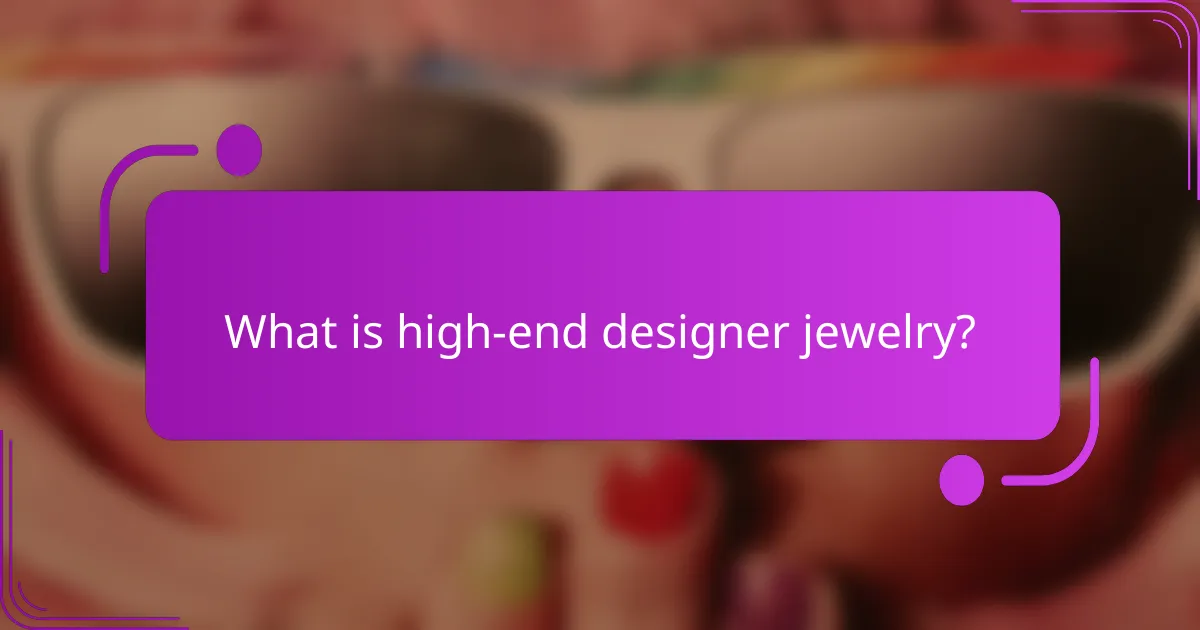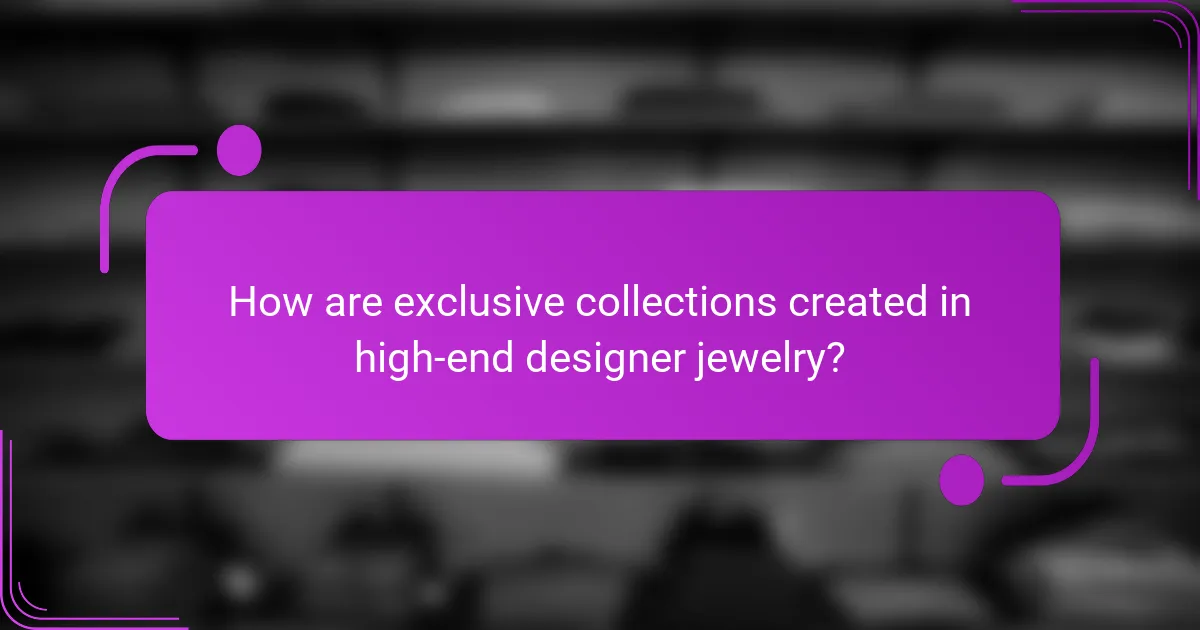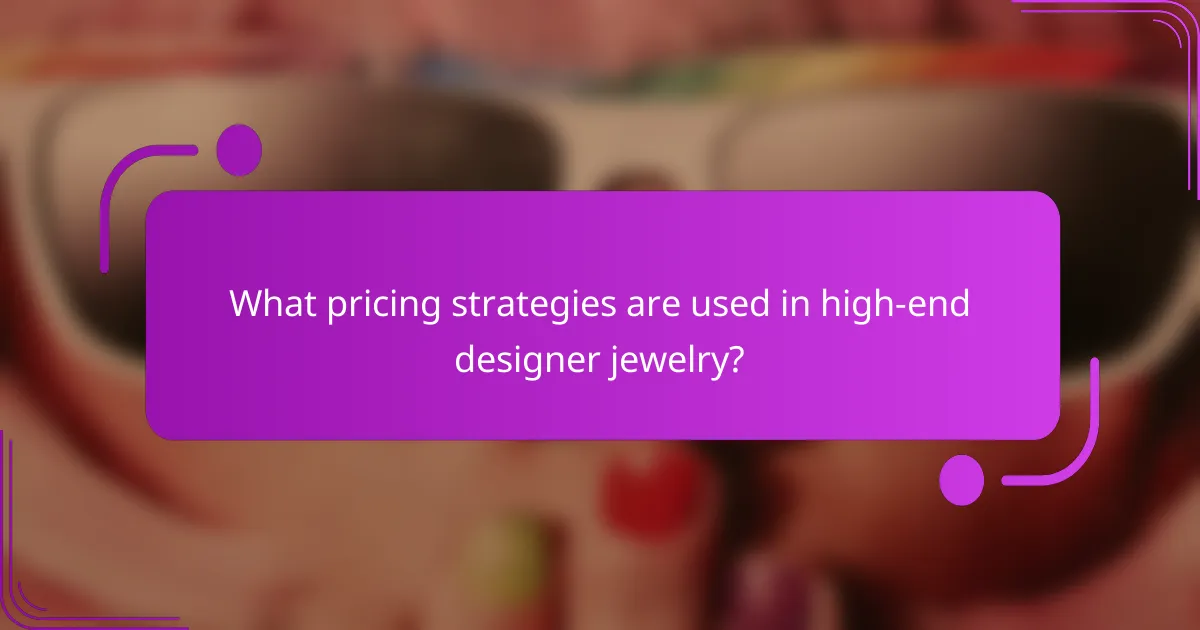High-end designer jewelry encompasses luxury jewelry pieces crafted by prestigious designers or brands, noted for their exceptional quality and exclusive designs. This category includes renowned names such as Cartier and Tiffany & Co., and features limited editions or unique creations that enhance desirability among collectors. The article explores the meticulous design process behind these exclusive collections, highlighting the use of rare materials and the influence of art and culture. Additionally, it examines various pricing strategies employed by high-end brands, including premium pricing, psychological pricing, and limited edition releases, which reinforce the perceived exclusivity and luxury of these jewelry items.

What is high-end designer jewelry?
High-end designer jewelry refers to luxury jewelry pieces created by renowned designers or brands. These pieces are often characterized by exceptional quality, craftsmanship, and exclusive designs. High-end designer jewelry typically uses precious metals and gemstones. The price point for such jewelry is significantly higher than mass-produced items, reflecting its exclusivity and artistry. Brands like Cartier and Tiffany & Co. are well-known in this category. High-end designer jewelry often features limited editions or unique creations. This exclusivity enhances its desirability among collectors and fashion enthusiasts.
How is high-end designer jewelry defined?
High-end designer jewelry is defined as luxury jewelry created by renowned designers or brands. This type of jewelry is characterized by exceptional craftsmanship and high-quality materials. High-end designer pieces often feature unique designs that set them apart from mass-produced jewelry. They are typically made with precious metals and gemstones, ensuring durability and aesthetic appeal. The exclusivity of high-end designer jewelry contributes to its desirability and often higher price point. Many pieces are produced in limited quantities, enhancing their rarity. Renowned brands like Cartier and Tiffany & Co. exemplify this category, known for their iconic designs and heritage.
What distinguishes high-end designer jewelry from other types?
High-end designer jewelry is distinguished by its superior craftsmanship, exclusive designs, and premium materials. The meticulous attention to detail in the creation process sets it apart from mass-produced jewelry. High-end pieces often feature rare gemstones and precious metals, enhancing their value. Additionally, the brand reputation and heritage play a crucial role in defining high-end designer jewelry. Brands like Cartier and Tiffany & Co. have a long history of luxury. The limited availability of these pieces creates a sense of exclusivity. High-end designer jewelry often comes with a higher price tag, reflecting its quality and status. This combination of factors makes high-end designer jewelry unique in the market.
What are the key characteristics of high-end designer jewelry?
High-end designer jewelry is characterized by exceptional craftsmanship, exclusive designs, and premium materials. The craftsmanship involves meticulous attention to detail, often requiring skilled artisans. Exclusive designs set high-end pieces apart, making them unique and sought after. Premium materials include high-quality metals, such as gold and platinum, and precious stones like diamonds and sapphires.
Additionally, high-end designer jewelry often features limited production runs, enhancing its exclusivity. Renowned brands typically create pieces that reflect their signature style and heritage. The use of innovative techniques and artistic concepts further defines these luxurious items. High-end jewelry is also associated with a higher price point, reflecting its quality and brand prestige.
Why is exclusivity important in high-end designer jewelry?
Exclusivity is crucial in high-end designer jewelry because it enhances perceived value and desirability. Limited availability creates a sense of rarity. This rarity attracts affluent consumers who seek unique pieces. High-end brands often produce small quantities to maintain this exclusivity. For instance, brands like Cartier and Tiffany & Co. release limited-edition collections. These strategies contribute to higher price points and brand prestige. Consequently, exclusivity drives consumer demand and loyalty in the luxury market.
How does exclusivity influence consumer perception?
Exclusivity significantly enhances consumer perception by creating a sense of rarity and prestige. When products are marketed as exclusive, they often evoke feelings of desirability. This is particularly true in high-end designer jewelry, where limited availability can elevate perceived value. Consumers associate exclusivity with higher quality and craftsmanship. Studies indicate that exclusive items can lead to increased consumer willingness to pay premium prices. For instance, a report by the Journal of Consumer Research found that consumers perceive exclusive brands as more luxurious. This perception can foster brand loyalty and enhance consumer satisfaction. Overall, exclusivity plays a crucial role in shaping how consumers view luxury products.
What role does brand reputation play in exclusivity?
Brand reputation significantly influences exclusivity in high-end designer jewelry. A strong brand reputation enhances perceived value and desirability. Consumers often associate reputable brands with quality, craftsmanship, and prestige. This association creates a sense of exclusivity, making products more sought after. For example, brands like Tiffany & Co. leverage their reputation to maintain high prices and limited availability. Research indicates that luxury brands with strong reputations can command prices up to 20-30% higher than lesser-known brands. Therefore, brand reputation is a critical factor in establishing and maintaining exclusivity in the luxury market.
What are the current trends in high-end designer jewelry collections?
Current trends in high-end designer jewelry collections include personalization, sustainability, and bold designs. Personalization allows consumers to create unique pieces that reflect their individual style. Sustainable practices are increasingly important, with brands using ethically sourced materials. Bold designs feature oversized gemstones and intricate craftsmanship. Minimalist aesthetics are also popular, emphasizing simplicity and elegance. Additionally, vintage-inspired styles are making a comeback, blending modern techniques with classic designs. These trends reflect consumer preferences for authenticity and uniqueness in high-end jewelry.
How do cultural influences shape these trends?
Cultural influences significantly shape trends in high-end designer jewelry. These influences dictate consumer preferences and purchasing behaviors. For instance, cultural heritage often inspires design motifs and materials used in jewelry. Trends can also emerge from social movements, such as sustainability, impacting the demand for ethically sourced materials. Regional styles and traditions contribute to the uniqueness of collections, appealing to specific demographics. Additionally, celebrity endorsements and fashion shows can shift consumer perceptions and drive trends. Historical context, such as art movements, further informs design aesthetics. Collectively, these cultural elements create a dynamic environment that shapes the high-end jewelry market.
What materials are commonly used in exclusive collections?
Exclusive collections commonly use high-quality materials such as gold, platinum, and diamonds. Gold is favored for its malleability and luster. Platinum is valued for its durability and rarity. Diamonds are prized for their brilliance and hardness. Other materials include precious gemstones like sapphires, rubies, and emeralds. These stones enhance the aesthetic appeal of jewelry pieces. Additionally, materials like silk and leather are sometimes used in accessories. The choice of materials reflects the exclusivity and craftsmanship of the collection.

How are exclusive collections created in high-end designer jewelry?
Exclusive collections in high-end designer jewelry are created through a meticulous design process. Designers often draw inspiration from art, culture, and personal experiences. They select unique materials such as rare gemstones and precious metals. Each piece is crafted with attention to detail and exceptional craftsmanship. Limited production numbers enhance the exclusivity of these collections. Collaborations with artists or thematic concepts can also define a collection’s uniqueness. High-end brands often utilize marketing strategies that emphasize rarity and luxury. This approach attracts affluent clients seeking distinctive jewelry pieces.
What is the design process for high-end designer jewelry?
The design process for high-end designer jewelry involves several key steps. Initially, designers conceptualize ideas based on trends, client preferences, or personal inspiration. They create sketches to visualize the design and refine details. Material selection is critical, focusing on high-quality gemstones and metals.
Prototyping follows, where a sample piece is crafted to assess aesthetics and functionality. Designers often collaborate with skilled artisans for intricate work. Once finalized, the piece undergoes quality checks to ensure it meets luxury standards.
This process emphasizes craftsmanship and attention to detail, which are essential in high-end jewelry. Each piece reflects a unique vision, often resulting in limited editions or one-of-a-kind creations.
How do designers source inspiration for their collections?
Designers source inspiration for their collections through various methods. They often draw from art, nature, and cultural history. Observing trends in fashion and lifestyle also influences their creative process. Travel experiences can spark new ideas and concepts. Collaborations with other artists or designers provide fresh perspectives. Additionally, personal experiences and emotions play a significant role in shaping their vision. Research indicates that exposure to diverse stimuli enhances creativity in design. This approach reflects the dynamic nature of high-end designer jewelry collections.
What stages are involved in bringing a collection to market?
The stages involved in bringing a collection to market include concept development, design, production, marketing, and distribution. Concept development involves identifying themes and inspirations for the collection. Designers create sketches and prototypes based on these concepts. Production follows, where materials are sourced, and pieces are manufactured. Marketing strategies are then implemented to promote the collection. Finally, distribution channels are established to sell the collection to retailers or directly to consumers. Each stage is crucial for a successful launch in the high-end designer jewelry market.
Who are the leading designers in high-end jewelry today?
The leading designers in high-end jewelry today include brands like Cartier, Tiffany & Co., and Van Cleef & Arpels. Cartier is known for its iconic designs and luxury craftsmanship. Tiffany & Co. has a strong reputation for its timeless elegance and signature blue boxes. Van Cleef & Arpels is celebrated for its intricate and artistic pieces. Other notable designers are Bulgari, known for bold colors and innovative styles, and Chopard, recognized for its fine watchmaking and jewelry. These designers consistently set trends and influence the luxury jewelry market. Their pieces often feature exquisite materials and unique designs that appeal to affluent consumers.
What makes these designers stand out in the industry?
High-end designer jewelry stands out due to its unique craftsmanship and exclusive materials. Designers often use rare gemstones and precious metals, enhancing the value of their pieces. Their collections feature intricate designs that reflect artistic vision and cultural influences. Many of these designers have a signature style, making their work instantly recognizable. They also maintain limited production runs, creating a sense of scarcity and exclusivity. High-end designers often collaborate with renowned artists or brands, elevating their status in the industry. Their commitment to sustainability and ethical sourcing further distinguishes them in a competitive market.
How do their unique styles influence collection exclusivity?
Unique styles significantly influence collection exclusivity in high-end designer jewelry. Designers often create pieces that reflect their personal aesthetic and craftsmanship. This distinctiveness sets their collections apart from mass-produced jewelry. Unique styles can include innovative designs, rare materials, and intricate techniques. Such characteristics enhance the desirability of the pieces. As a result, limited availability increases perceived value. High-profile collaborations or themed collections further amplify exclusivity. Collectors are often drawn to these unique attributes, driving demand and higher pricing.

What pricing strategies are used in high-end designer jewelry?
High-end designer jewelry employs several pricing strategies. These strategies include premium pricing, which positions products at a higher price point to reflect exclusivity. Another strategy is psychological pricing, where prices are set just below a round number to create a perception of value.
Additionally, high-end brands often use price skimming, initially setting high prices that gradually decrease over time. This approach captures early adopters willing to pay more. Moreover, limited edition releases create urgency and allow for higher pricing due to scarcity.
Furthermore, high-end jewelry brands may engage in bundling, offering complementary pieces together at a perceived discount. This encourages customers to purchase more items. Lastly, prestige pricing is common, where prices are maintained at a high level to reinforce the brand’s luxury image.
These strategies are validated by market trends showing that luxury goods maintain value through perceived exclusivity and brand prestige.
How is the pricing of high-end designer jewelry determined?
The pricing of high-end designer jewelry is determined by several key factors. These include the quality of materials, craftsmanship, brand reputation, and market demand. Precious metals and gemstones significantly influence pricing due to their rarity and quality. For instance, diamonds’ pricing is often based on the 4Cs: cut, color, clarity, and carat weight. Craftsmanship impacts pricing as well; intricate designs and skilled artisanship increase production costs. Brand reputation plays a critical role; established brands can command higher prices due to perceived value. Additionally, market demand affects pricing; limited editions or exclusive collections may have inflated prices due to scarcity. Overall, these elements combine to establish the final price of high-end designer jewelry.
What factors contribute to the cost of exclusive collections?
The cost of exclusive collections is influenced by several key factors. Firstly, the quality of materials used significantly affects pricing. High-end materials like rare gemstones and precious metals are more expensive. Secondly, the craftsmanship involved plays a crucial role. Skilled artisans create intricate designs, which adds to labor costs. Thirdly, brand reputation influences pricing. Established luxury brands command higher prices due to their prestige. Fourthly, limited availability can drive up costs. Exclusive collections often have a small number of pieces, creating scarcity. Lastly, marketing and branding strategies also contribute to the overall cost. High investment in advertising and brand positioning raises the price of exclusive collections.
How do market demand and brand positioning affect pricing?
Market demand and brand positioning significantly influence pricing strategies in high-end designer jewelry. High demand for exclusive collections allows brands to set higher prices. This is because consumers often perceive scarcity as a sign of quality and desirability. Conversely, low demand can force brands to lower prices to attract buyers. Brand positioning also plays a critical role. A strong brand image can justify premium pricing. For example, luxury brands like Tiffany & Co. leverage their heritage and craftsmanship to command higher prices. In contrast, brands with weaker positioning may struggle to maintain high price points. Market trends and consumer preferences further impact these dynamics, making it essential for brands to adapt their pricing strategies accordingly.
What are the common pricing strategies in the luxury market?
Common pricing strategies in the luxury market include premium pricing, psychological pricing, and skimming pricing. Premium pricing sets prices high to reflect quality and exclusivity. This strategy reinforces the luxury brand image. Psychological pricing leverages consumer perception, often pricing items just below a round number. This tactic enhances the perceived value of the product. Skimming pricing involves setting high initial prices that gradually decrease over time. This strategy captures early adopters willing to pay more. These strategies are supported by market research indicating that luxury consumers prioritize brand prestige and quality over price.
How do luxury brands utilize psychological pricing techniques?
Luxury brands utilize psychological pricing techniques to enhance perceived value and exclusivity. They often set prices just below a round number, such as $999 instead of $1000. This strategy creates a perception of a better deal. Luxury brands also employ prestige pricing, where high prices signal quality and status. This aligns with consumer psychology that associates higher prices with superior products. Additionally, limited-time offers and exclusive collections create urgency and enhance desirability. Research shows that consumers are more likely to perceive high-priced items as more luxurious. This pricing strategy effectively reinforces brand positioning in the high-end market.
What role does perceived value play in pricing strategies?
Perceived value significantly influences pricing strategies in high-end designer jewelry. It reflects the customer’s belief about the worth of a product. High perceived value can justify higher prices. This is often achieved through branding, quality materials, and exclusivity. For instance, luxury brands like Cartier and Tiffany leverage their heritage and craftsmanship to enhance perceived value. Research shows that consumers are willing to pay a premium for products they perceive as high-quality or exclusive. A study by the Journal of Consumer Research indicates that perceived value directly impacts purchasing decisions. Therefore, effective pricing strategies must align with perceived value to maximize revenue.
What tips should consumers consider when purchasing high-end designer jewelry?
Consumers should prioritize authenticity when purchasing high-end designer jewelry. Verify the brand’s reputation and ensure the jewelry comes with a certificate of authenticity. Research the designer’s collections to understand the value and craftsmanship. Inspect the materials used, such as precious metals and gemstones, as these significantly impact quality and price. Consider the resale value; some pieces retain or appreciate in value over time. Evaluate the return policy and warranty offered by the retailer. Seek out trusted retailers with positive customer reviews to avoid counterfeit products. Additionally, be aware of the latest trends, as they can influence pricing and desirability.
How can buyers ensure they are getting authentic pieces?
Buyers can ensure they are getting authentic pieces by purchasing from reputable dealers. Researching the dealer’s history and customer reviews is essential. Requesting certificates of authenticity can provide verification. Familiarizing oneself with the brand’s specific markings or characteristics aids in identification. Comparing prices with official retail prices can indicate authenticity. Consulting with experts or appraisers can also confirm authenticity. Many high-end brands offer online resources for verification. Engaging with the brand’s official website can provide additional guidance on authenticity checks.
What should consumers know about investment potential in designer jewelry?
Designer jewelry can be a valuable investment. Its potential for appreciation is influenced by brand reputation, craftsmanship, and rarity. High-demand brands like Cartier and Tiffany often see significant value increases over time. Limited edition pieces tend to appreciate more than mass-produced items. Market trends indicate that certain designer pieces can yield returns of 20% or more annually. Historical data shows that fine jewelry has outperformed traditional investments like stocks in some cases. Consumers should consider the long-term marketability of the piece when investing. Authenticity and provenance are crucial factors that affect resale value.
High-end designer jewelry is defined as luxury jewelry crafted by renowned designers or brands, characterized by exceptional quality, craftsmanship, and exclusive designs. This article explores the defining attributes of high-end designer jewelry, including its unique materials, craftsmanship, and the importance of exclusivity. It discusses current trends, the design and production processes, and the pricing strategies employed by luxury brands. Additionally, the article highlights key designers in the industry and provides insights for consumers on purchasing authentic pieces and understanding investment potential in designer jewelry.